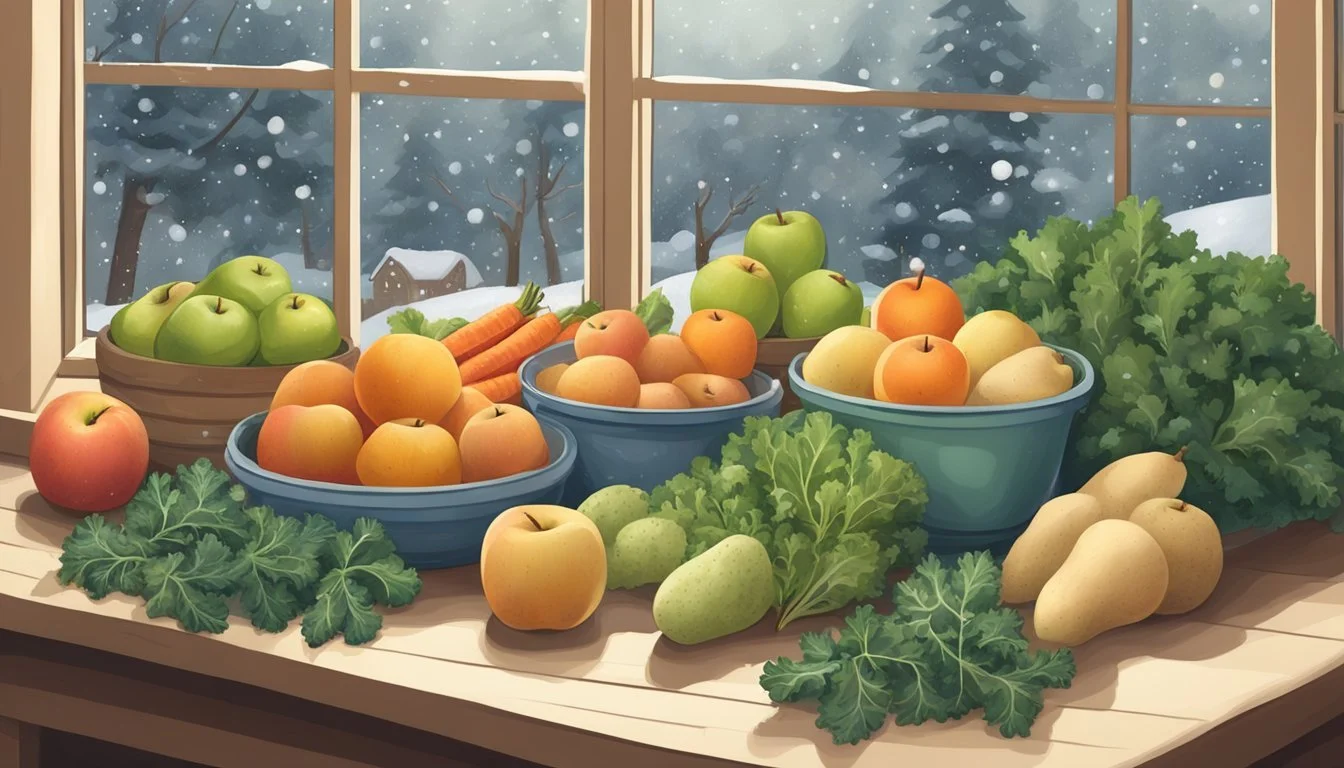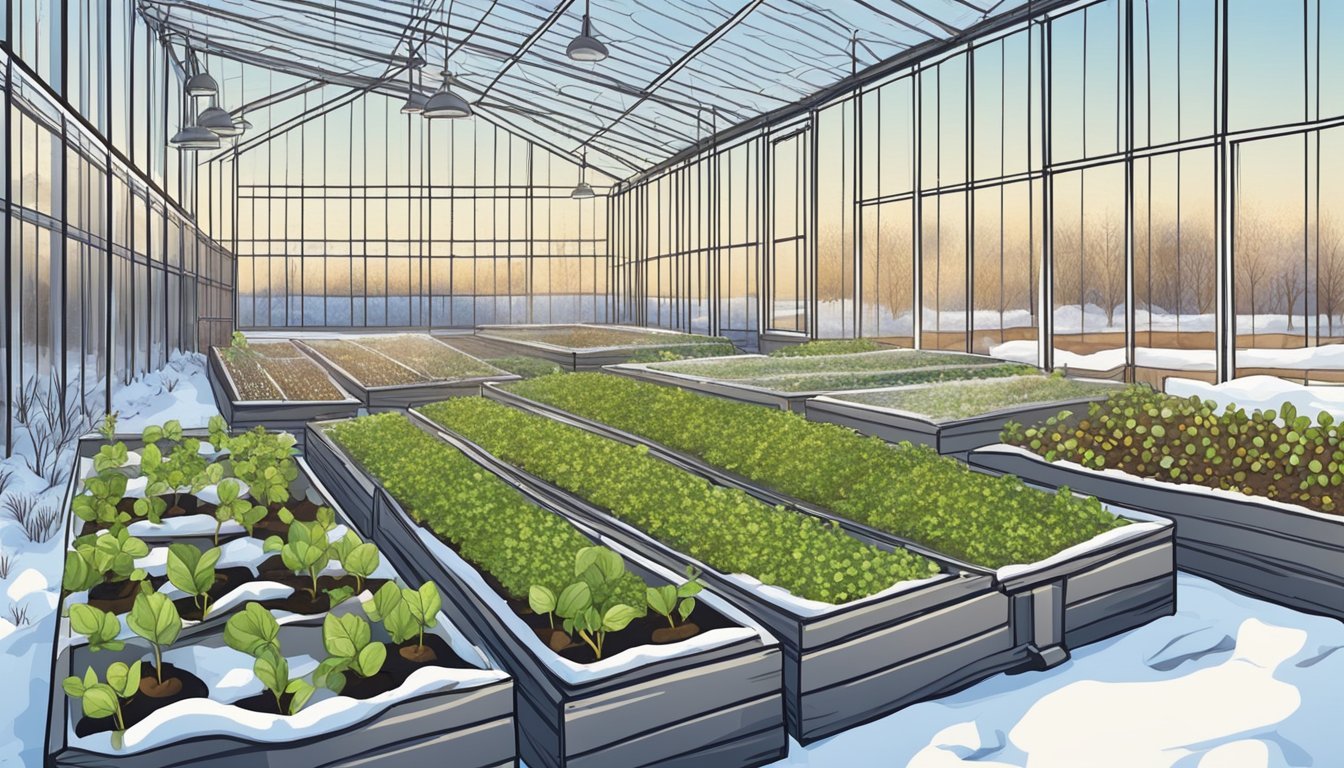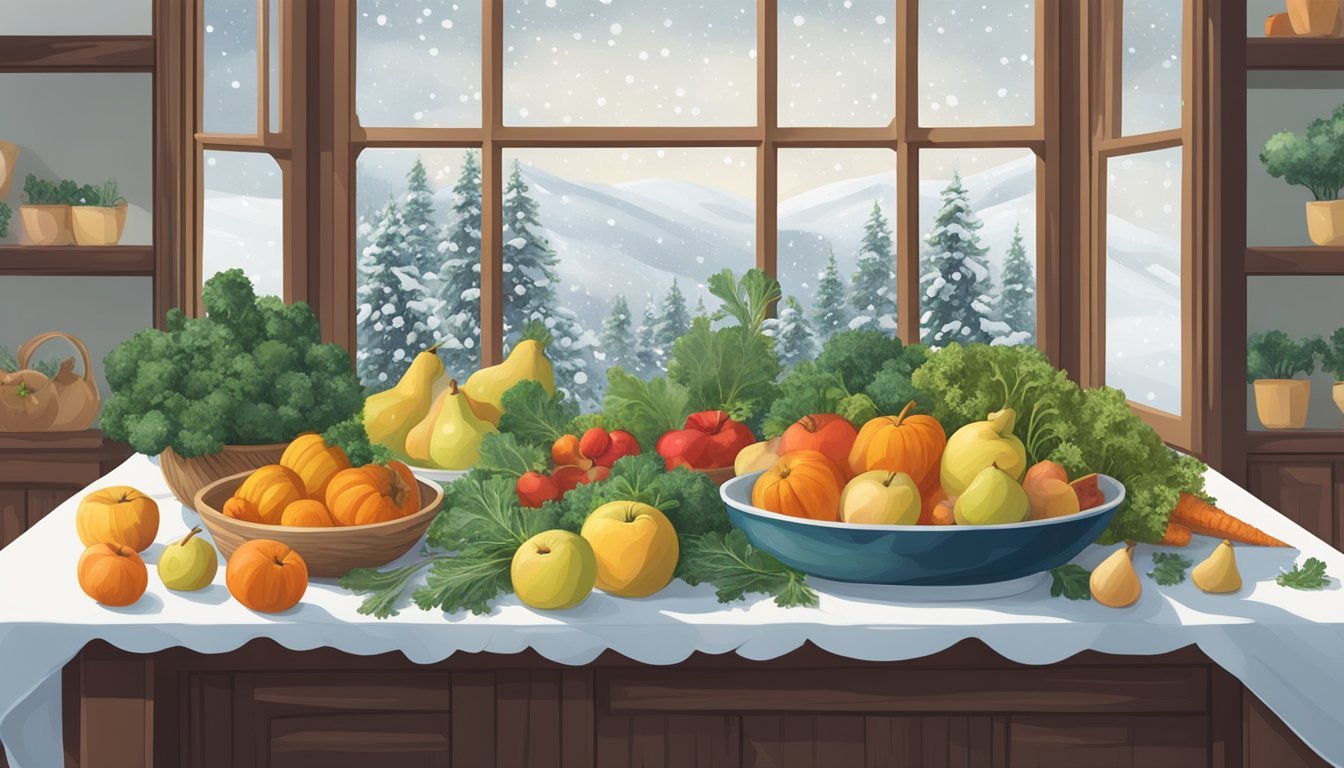Ohio Seasonal Fruit & Vegetables in January
A Guide to Fresh Produce
This Article is Part of our Ohio Seasonal Fruit & Veg Calendar
In Ohio, January marks a time of colder temperatures and a quieter growing season; however, this does not translate to a lack of fresh produce. With a focus on storage-hardy and cold-tolerant crops, Ohioans still enjoy a variety of fruits and vegetables. Amidst the frost, root vegetables and some hearty greens thrive, while stored or greenhouse-grown produce remains available to round out the local offerings.
The state’s farmers work with the season to ensure that even in the depths of winter, consumers have access to nutritious and flavorful produce. Hardy vegetables like kale and cabbage can withstand Ohio's January chill, while stored apples and pears continue to offer sweetness and crunch. These items, along with winter squash and a selection of greenhouse-grown vegetables, provide the backbone for January's seasonal availability in Ohio.
Ohio's food landscape in January may not be as abundant as the summer months, but there is no shortage of options for those seeking to incorporate seasonal produce into their meals. These offerings not only support local agriculture but also provide the opportunity to enjoy the flavors of the season, even as the winter lingers. Ohioans have learned to adapt their culinary practices to incorporate these winter-friendly varieties, thus celebrating the state's agricultural diversity year-round.
Seasonal Overview of Ohio Produce
January in Ohio marks the depth of winter, a time when the state's produce availability is shaped heavily by the cold weather. This month, the focus of local agriculture shifts toward storage crops and sturdy winter-friendly produce.
Climate and Seasonality Impact
Ohio winters typically bring cold temperatures and snow, influencing what produce is available. The colder months see a decline in the variety of fresh produce, but many root vegetables and winter-hardy vegetables remain available due to their ability to withstand frost.
Monthly Harvest Calendar
Root Vegetables: carrots, potatoes, beets (how long do beets last?), turnips
Brassicas: kale, brussels sprouts (how long do brussels sprouts last?)
Other Vegetables: leeks, winter squash
Storage Crops: apples, onions
Greenhouse Grown: lettuce, herbs
Understanding Seasonality
The concept of seasonality in Ohio hinges on growing cycles affected by temperature, daylight, and weather patterns. In January, produce that reaches its peak includes crops that are either stored from the fall harvest or can grow in the state's cold climate.
Importance of Seasonal Eating
Eating seasonally in January means adjusting diets to incorporate more storage and root vegetables, which offers optimal freshness and aligns with natural local growing cycles. This practice supports local farmers and reduces the carbon footprint associated with importing non-seasonal food.
Benefits of Local Produce
Local Ohio produce in January, although limited, is typically more nutrient-dense due to its freshness. It has a lower carbon footprint than out-of-state or imported foods and supports the local economy.
Varieties of Ohio Produce
Ohio provides a range of produce during the winter:
Root Vegetables: Local farms supply root vegetables, known for their robust storage potential and versatility in winter meals.
Brassicas: Crops like kale and brussels sprouts can often survive the winter, offering greens for seasonal dishes.
Citrus Fruits: While not native to Ohio, some citrus fruits can be available from greenhouse growers.
Storage crops and greenhouse produce: These maintain a presence in the market to bridge gaps in fresh produce during the winter months.
Fruit Highlights in January
January in Ohio offers a more limited selection of local, fresh fruit, as the winter season is not peak harvesting time. However, certain fruits, particularly citrus, are at their peak of ripeness and flavor, providing both nutritional value and a variety of uses in recipes.
Citrus Fruits Delight
Citrus fruits are a standout during the winter months, with their peak seasonality bringing a burst of flavor and a wealth of vitamin C to Ohio's January table. Oranges, lemons, and grapefruit feature prominently in seasonal fruit baskets. Oranges are versatile in both sweet and savory dishes, while lemons add a bright acidity to meals and grapefruit offers a bittersweet kick that can be enjoyed fresh or in recipes.
Oranges: Optimal ripeness for sweet and tangy flavor
Lemons: Ideal tartness for culinary uses
Grapefruit: Bold, tangy, and slightly sweet
Seasonal Berries and Pomegranates
Although berries are generally associated with summer, certain types are available in grocery stores due to modern storage techniques. Pomegranates, with their ruby-red arils, are also in season. These fruits are not just delicious; they are a powerhouse of antioxidants and can be used in various recipes ranging from salads to desserts.
Pomegranates: Sweet and tart, packed with nutrients
Storage and Preservation
Winter emphasizes the importance of proper storage and preservation techniques to extend the life of seasonal fruit. Citrus fruits tend to have a longer shelf life and can be stored at room temperature or refrigerated. They can also be juiced or zested for long-term use. Pomegranates can be stored in a cool, dry place or refrigerated.
Citrus Storage: Room temperature for short term, refrigerated for extended life
Pomegranate Storage: Best kept cool and dry or refrigerated
Vegetable Selection in January
In January, Ohio's cooler climate offers an abundance of certain vegetables that can withstand the frigid temperatures. Storage methods and seasonal availability make it a suitable time for enjoying specific varieties of vegetables that are characteristic of the winter season.
Cruciferous Vegetables
Broccoli (how long does broccoli last?) and cauliflower (how long does cauliflower last?) stand out in January, thriving in Ohio's climate. Both can be found fresh during this time and are versatile for a range of recipes, from soups to roasted sides. Brussels sprouts and cabbage also fall into this category, offering robust flavors and the capacity to be stored for extended use.
Root Vegetables
The root vegetables category includes several hardy selections ideal for cold weather. Carrots, turnips, beets, sweet potatoes, rutabagas, and celery root are at their peak. These vegetables benefit from the cool grounds of Ohio, which enhance their natural sweetness and make them perfect for comforting winter dishes.
Notable examples:
Carrots: Crunchy and sweet, ideal for stews.
Beets: Earthy flavor, suitable for roasts and salads.
Sweet Potatoes: A multipurpose vegetable, excellent for baking or as mash.
Leafy Greens and More
Leafy greens such as kale, spinach, and collards are readily available and can be utilized in warm meals or fresh salads. Their resilience to the cold makes them staples for January harvests. Lettuce remains a favorite for salads and sandwiches, even in the colder months, thanks to Ohio's controlled storage facilities that extend its availability.
Leafy greens selections:
Kale: A nutrient-dense choice for sautés and chips.
Spinach: Tender and flavorful, ideal for salads and omelets.
Collards: Robust and hearty, commonly used in slow-cooked recipes.
Cooking and Recipes
The cold season in Ohio calls for hearty meals, fresh salads, and the art of preserving the flavors of winter produce. Cooking in January centers around robust flavors and preserves, showcasing how even in the depths of winter, one can still enjoy the region's bounty through a variety of recipes.
Winter Comfort Foods
Cooking with January's produce in Ohio manifests in warming stews and savory bakes. Root vegetables like beets and the hardy, leafy greens such as kale are staples in seasonal comfort food. They can be transformed into satisfying dishes like beetroot stews that offer deep, earthy flavors (What wine goes well with earthy flavors?) or kale-infused soups that not only warm the body but also provide necessary nutrients.
Recipes to Try:
Beetroot and Barley Stew
Savory Kale and White Bean Soup
Healthy Salads and Sides
January's produce includes a variety of cruciferous vegetables like broccoli and cauliflower that lend themselves well to light, nutritious salads and sides. Combining these with citrus fruits — abundant during the season — adds a fresh, bright flavor to any dish. A broccoli and orange salad or a lemon-infused cauliflower rice could be the perfect accompaniment to any main course.
Salad Recipes:
Crunchy Broccoli and Orange Salad
Lemon Cauliflower Rice
Preserves and Fermentations
Winter is an excellent time for creating preserves and engaging in fermentation, ensuring that the flavors of seasonal produce can be enjoyed throughout the year. Ohioans might prepare a spicy cabbage salsa or pickle their root vegetables. Fermenting foods like kale and beets enhances their flavor and increases their shelf life, which is particularly useful during the colder months.
Preservation Ideas:
Spicy Cabbage Salsa
Fermented Beets and Kale
Making use of January's seasonal offerings, Ohio residents can enjoy a wealth of dishes that bring warmth, nutrition, and variety to their winter tables.
Growing Your Own
In Ohio, January's chilly weather necessitates a strategic approach for those dedicated to cultivating their own produce. The season brings unique challenges and opportunities for both novice and experienced gardeners.
Winter Gardening Tips
Gardening during the cold months in Ohio requires understanding the local climate and selecting the right produce that can withstand winter conditions. Insulation and protection are pivotal for a successful winter garden. Gardeners often employ methods such as cold frames, greenhouses, and mulching to safeguard their crops against the freezing temperatures. Crop rotation practices are also crucial to maintain soil health and prevent pest build-up over the winter season.
Listed below are vegetables that typically fare well during Ohio's winter:
Kale
Spinach
Carrots
Garlic
Leeks
Seed Selection and Planning
As winter persists, Ohio farmers begin to plan for their spring gardens. Seed selection is a primary step, and one must choose seeds that are robust and well-suited for Ohio's climate. Catalogs from local nurseries can offer a variety of optimal seed options, including heirloom and hybrid varieties.
When planning, gardeners should consider the following:
Last frost date: To identify the appropriate time for transplanting seedlings outdoors.
Garden layout: To maximize space and ensure adequate sun exposure.
Companion planting: To enhance growth and deter pests naturally.
A strategic layout for a spring garden might feature:
Area Vegetables Sunlight Requirement A Tomatoes Full Sun B Peppers Full Sun C Lettuce Partial Shade D Herbs Varies
By adhering to these winter gardening tips and careful seed selection and planning, Ohio's residents can cultivate flourishing gardens year-round.
Seasonal Food Events in Ohio
January in Ohio marks a time when residents can enjoy a variety of seasonal events centered around locally-grown produce despite the winter chill. These events offer opportunities for learning, tasting, and celebrating Ohio's winter bounty.
Farmers' Markets and Festivals
Ohio Winter Farmers' Markets: Even during the coldest months, some Ohio farmers' markets remain open, providing access to winter produce and goods. These markets often feature indoor settings where vendors sell root vegetables, preserves, and hot foods.
Cleveland Winter Farmers' Market: Patrons can find a selection of indoor winter markets in areas like Cleveland where local produce and artisanal foods are showcased.
Seasonal Cooking Classes
Cooking with Seasonal Produce: Culinary enthusiasts can enroll in cooking classes and workshops focused on preparing seasonal dishes. These classes are facilitated by local chefs who specialize in creating delicious meals using winter ingredients like squash and root vegetables.
Local Culinary Schools and Kitchen Workshops: Places like the Western Reserve School of Cooking may offer classes for individuals eager to transform seasonal foods into warming winter meals.
Agricultural Fairs and Exhibits
Educational Exhibits: The month of January might not be the peak time for outdoor agricultural fairs in Ohio, but it's an ideal period for indoor educational exhibits that focus on the state’s agricultural practices and winter produce.
Ohio State University Extension: This institution may conduct events and exhibits that educate Ohioans on seasonal farming and local produce through various programs and workshops.
In these events, Ohioans can participate and gain both education and enjoyment from the diverse offerings that reflect the state's rich agricultural heritage.
Buying Guide and Tips
When purchasing seasonal fruits and vegetables in Ohio during January, customers should focus on sourcing locally where possible to ensure freshness and support local economies. A wealth of produce can be found despite the cold weather, and understanding how to choose and decipher labels can greatly enhance the shopping experience.
Where to Buy Seasonal Produce
Shoppers in Ohio have several options when looking for seasonal produce in January. Local farmers' markets are an excellent choice as they often provide a variety of fresh, locally-grown products. Additionally, these markets support Ohio's agricultural community. Consumers can also visit co-ops and specialty food stores which may offer a curated selection of in-season fruits and vegetables. For convenience, supermarkets often stock seasonal items and may also provide information on the origin of their produce.
Farmers' Markets
Co-ops
Specialty Food Stores
Supermarkets
Selecting the Best Produce
Selecting high-quality produce is crucial for the best taste and nutritional value. Shoppers should look for fruits and vegetables that are firm, brightly colored, and free from blemishes or soft spots, which are indicators of freshness. For instance, a ripe butternut squash should have a solid beige color and feel heavy for its size; soft spots could indicate that it's past its prime. Purchasers should feel produce for firmness and check the skin or rind as an initial sign of quality.
Firm to the touch
Bright, consistent color
Free from blemishes or soft spots
Understanding Labels
Labels on produce can inform consumers about important factors including organic certification, GMO (genetically modified organism) status, and sometimes even the farm of origin. If a product is labeled "USDA Organic," it meets strict government standards related to how it was grown and processed. Non-organic options may be more affordable but could have been grown using conventional pesticides and fertilizers. For those concerned with GMOs, look for the Non-GMO Project Verified seal to ensure produce is GMO-free. Understanding these labels helps consumers make educated decisions based on their personal preferences regarding health and environmental impact.
USDA Organic: meets organic standards
Non-GMO Project Verified: GMO-free
Local farm identification: supports local businesses
Reflection on Seasonal Eating
Embracing the practice of eating seasonal fruits and vegetables offers numerous benefits. It aligns consumers with the natural harvest cycles and supports local farmers. One may notice a stark difference in flavor when consuming produce that is in season; fruits are sweeter, and vegetables are more flavorful, as they are picked at the peak of their ripeness.
From a health perspective, seasonal produce can be richer in nutrients. They have not been subjected to extended storage or long-distance transportation, which can deplete nutritional value. Additionally, the variety in a seasonal diet can contribute to a broader intake of vitamins and minerals as different produce contain different nutritional profiles.
Seasonal eating also holds importance in sustainability. It minimizes the carbon footprint associated with transporting produce over long distances and supports the local economy. When consumers purchase from local growers, they are investing in their community and helping to keep the local agricultural sector vibrant.
Here is a brief outline of the benefits of seasonal eating in January in Ohio:
Flavor: Fresh, crisp, and robust taste from produce such as winter squash and apples.
Health: Nutrient-dense offerings like kale and parsnips are available, which are great for winter nourishment.
Sustainability: Reduced environmental impact through minimal transportation and support of Ohio's agricultural infrastructure.
Community: Strengthening local connections and economies by purchasing from nearby farmers markets or co-ops.
Conclusion
In January, those residing in Ohio have the opportunity to enjoy a range of fruits and vegetables that are at their peak during this time of the year. The winter season does not hinder the variety of produce that one can incorporate into their diet. From storage crops like winter squash and potatoes to hearty greens that can withstand the cold, these items remain staples in the local diet.
It's important for consumers to recognize the benefits of consuming produce that coincides with the growing cycles in Ohio. Not only does this support local farmers and the economy, but it also promotes environmental sustainability by reducing the carbon footprint associated with long-distance food transportation.
Seasonal Produce Available:
Apples
Beets
Carrots
Onions
Potatoes
Squash
Turnips
Ohioans are encouraged to explore these seasonal offerings through various recipes and preparations that highlight the natural flavors and nutritional value of the produce. Visiting local farmers' markets or subscribing to a CSA (Community Supported Agriculture) box are excellent ways for individuals to obtain the freshest seasonal produce while supporting their local community.
As each season brings a new harvest, Ohio's communities tend to come together in celebrating and utilizing what the land provides. January in Ohio demonstrates that even in the midst of winter's chill, the cycle of growth persists, offering its bounty to those who seek it.










